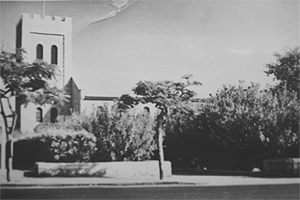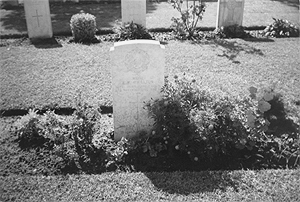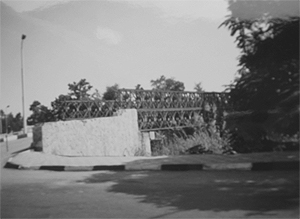
AN AIR FORCE BRAT IN THE CANAL ZONE - 1949 to 1951
As Remebered By Bill Thomas
I was born in January 1941, a fortnight after my parents had been bombed out of their house in Cardiff. My father was in the Royal Air Force. A year later he was posted to Stanmore, and mother followed him. We lived in " hirings" found by the RAF. In 1943, father went to Malta and was, in effect, away from the family, apart from occasional leave, until the summer of 1948. Then he was posted to RAF Abu Sueir.
Mother and I left Victoria Station at the end of January 1949, bound for Marseilles, via Folkestone, Boulogne and Paris. The journey from Paris was overnight. I remember a Frenchman trying to find a seat among a whole gang of British military wives and children!
The SS Providence took us from Marseilles to Port Said. The first three days were very rough - the ship actually went backwards at times! Then the weather cleared and the rest of the voyage was very agreeable. The best thing about the voyage was the food. It was the first time in my life that I had seen unlimited - and unrationed - food. A bowl of sugar; piles of fruit; fresh French bread every day. Mother and her friends enjoyed the wine which was on the table every meal!
Father met us at Port Said and an RAF bus took us to Aryshea where father had obtained a "hiring" from Mr Kalini - the station master at Nefisha. It was on the first floor of an unfinished block right at what was then the edge of the desert. Across the road was a large Ford showroom. To the east, a row of small houses for Egyptian Suez Canal workers.
School was at RAF Ismailia, by bus each morning. For most of the year, lessons ended at about 1pm. Afternoons were spent at the French Beach or, in the holidays and weekends, at the Blue Lagoon For me, the best thing was having my father living with us full time. On Sundays, we went either to the Garrison Church at Moascar, or the small C of E church in Ismailia (near the port). While we were there, the Canal Army Bus Service was created - three tonners converted with steps and rows of seats. The conductors were National Servicemen - who were trained to use the Bell-punch ticket machines.
I recall the man bringing a large, dripping, block of ice for the ice-box (no fridges, then). And the lad with the brass castanets bringing drinks round the streets every afternoon. We were not allowed them. Germs - and who knows what else. Shopping was done in Ismailia town - the Greek and French Co-ops; the Pharmacie (for "poudre Suisse" against heat rash) - and at the NAAFI just by the railway station.
At the end of 1949, a married quarter became available at Abu Sueir and we moved there, with Ahmed, the Nubian servant who was with us for most of the tour. I went to the RAF school. There was a fearsome headmistress (whose name I don't remember) who introduced us to a new form of discipline called "the cane". Most alarming - though used as a threat, mostly!
There were long holidays. Aged 9, I could go anywhere and found my way to the MT Yard where a succession of friendly fitters allowed me to "help". I learned how to adjust tappets but, best of all, they taught me to drive. The first vehicle I drove was a 10 ton Crossley lorry; I had to stand with both feet on the clutch to change gear. I progressed through Hillman staff cars to first 45 ft then 60 ft "Queen Marys". Believe it or not, the long-suffering chaps taught me how to reverse these articulated vehicles into goal posts on the sandy football pitch. I learnt things from these kindly and patient men that have stayed with me for 68 years.
There was a pool at Abu Sueir which we used in the summer as trips to the French Beach were less easy to organise. We played cricket and football. In February 1950 I broke my arm while in goal and had to be taken across the desert in an ambulance with an armed guard to the BMH at Fayid for the fracture to be re-set. I can still smell the ether…!
In 1949 my elder brother - then at Sandhurst - came out for a week. He flew into Cairo, so we had the exciting trip through the "Canal Zone "border" at Tel-el-Kebir to meet him. That enabled us to make our first visit to the Pyramids. In 1950, my other brother spent a week's holiday. He flew to Fayid in a civil airliner. My parents later arranged a fortnight's holiday for us in Kyrenia - flying from Fayid in a Dakota of Cyprus Airways. I was very disappointed to discover that a "self-drive" hire car actually had to be driven by my father.
Every winter there was a searchlight tattoo at Moascar - with teams racing to assemble Jeeps brought into the arena in packing cases. The target was four minutes and the winner drove off proudly!
In January 1950 we had a trip to southern Egypt, staying one night in Cairo - Pyramids again - and then by overnight train to Luxor. That was a wonderful holiday. The Valley of the Kings; Karnak and all the local archaeological sites. I remember the adults complaining that there was "some other people" at the Valley of the Kings, which we went to by horse-drawn gharry.
Father's posting ended in March 1951and we flew back from Fayid in Transport Command Hastings (No 614), stopping the first night at Castel Benito and the second at Istres (the French Air Force base near Marseilles). I remember the magical sight of Malta and Sardinia spread out below us. The weather was clear all the way to France. For the last leg to RAF Lyneham, we were in cloud and it was cold and pouring with rain in Wiltshire.
I was then sent to boarding school for seven miserable years. Eventually I became a solicitor and from 1975 to 2002 appeared, most Fridays, on the BBC Radio 2 Jimmy Young Programme as the "Legal Beagle". But I have never forgotten the wonderful experience - although, at the time, of course, I just assumed that it was what life was supposed to be.
I did go back to Egypt in 1996 and will talk about this next time.
Forty-one years after flying out of Fayid, I decided to return to Egypt with my wife. In October 1996 we stayed six nights in Cairo - and I took her to all the obvious sights, the Museum, Pyramids, Mosques etc.
However, my hope was to be able to return to Ismailia - where I had lived from Feb 1949 to March 1950. From 1975 to 2002 I appeared most Fridays on the BBC R2 "Jimmy Young Programme". When I mentioned that I was going back, a listener, Michael Wharton, got in touch, as his father (a Major in the RASC) had been killed in 1952 in the revolution.
I wanted maps. At that time, the MOD Map Department still existed in Surrey - and they sent me (free) lots of proper, British, Ordnance maps of the Canal Zone, which proved very useful. In order to visit the CWG Cemetery at Moascar, I contacted the Military Attaché at the Cairo Embassy who obtained approval from the Egyptian Ministry of Defence.
We hired a taxi and asked him to take us to Ismailia but NOT by the direct motorway. I wanted to go by Bilbeis, Tel-el-Kebir and along the Sweetwater Canal. The chap had no idea where any of these places where or how to get there - and had never looked at a map. However, by getting him to go to one town, then asking there for the next - we made it!
North of the road from Zagazig, the countryside was well farmed, by people doing it by hand, by donkey and buffalo. Tractors were unknown; shadufs everywhere. We did see a couple of diesel pumps drawing water from the Sweetwater Canal to irrigate, but Pharaonic methods still ruled the roost. It was harvest time and the only concession to the 1990s was hand-winnowing onto a sheet of polythene. The road was still the same: narrow, raised and with the trees painted white.
The villages had grown, of course, but not that much. At Tel-el-Kebir one couldn't see the British Cemetery but there was a road block exactly where the old RMP oil-drum checkpoint had been (where one had to abandon military vehicles and uniform and go to Cairo in mufti - from 1948 onwards).
I was not allowed to go to the former RAF Abu Sueir (where I'd lived for over a year) but could see the water tanks and concrete shelters for aircraft. The airfield was bombed in 1956 and there may have been many changes.
The Treaty Road junction just before Nefisha was still there (and the Bailey Bridge). The level crossing - always closed as soon as the locals saw any British traffic - was in exactly the same place. The township had spread both sides of the Sweetwater Canal but the roadside shops and cafés were unchanged.
The road followed the same route into Ismailia, though the right hand side was military (as it wasn't in my day). With my permission to visit Moascar Garrison, the approach was exactly the same, up from the Sweetwater Canal, across the railway and left opposite the AKC Cinema - still used as such by the Egyptian military! The main gate to Moascar is manned by grandsons of the "Gallant and Glorious" - and it took nearly half an hour to get past the barrier - despite a letter in Arabic from the Egyptian MOD.
Moascar was very little changed, though the church is derelict and its windows broken. I was take to the Adjutant's office and then to the CO (who was in the same room as in British days). Once I explained why I was there and that I could take them virtually anywhere round both Moascar and RAF Ismailia, they were all smiles. It was odd being the oldest person in a place where I had once been among the youngest. The kerbstones were still painted alternate black and white...!

Moascar Church
taken in August 1951 by Mrs Mabel Reed,
whose husband was killed in November 1951
The CWG Cemetery is about a mile out of the Garrison; you turned right at the roundabout along the road from the main gate, past the football ground and into the desert. It was immaculate: green and watered and beautifully tended. Major Wharton's grave was there - he was killed in French Square.

The grave of Major
R.H. Wharton
at Moascar Cemetery
Ismailia had grown tremendously; the population was over a million. The town centre was very run down; the streets were dirty and there had been demolition and half-hearted re-building. The French Pharmacie and Sphinx Bookshop no longer exist. We had lived in Arishiya, under the railway bridge and I managed to track it down. In 1949 it was on the edge of the desert - in 1996 in the middle of a vast new suburb.
We were the only westerners in Ismailia that day. We had a plain lunch in a nice fish restaurant where we were made very welcome. Walking back to the car in French Square (only a section of which is original because that was where the battle started) a young man was listening to a BBC English lesson on his radio. We stopped and chatted and I told them why I was there. We were joined by two other men who said that their parents had told them how the town had been fifty years before. The stallholder insisted on giving us bottles of Coca-Cola and I remembered that it was in Ismailia in a café on the dual-carriage way that ran south from the railway bridge to the Sweetwater Canal that I had my first taste of Coke!

The Bailey Bridge
over the Sweetwater Canal
just west of the entrance to Ismailia
The Canal in the town had not been widened and the old lifting bridges were still there. The church had gone, but there was a new one being built on the north-west corner of French Square.
There was not enough time to go to the Suez Canal itself. I wondered whether French Beach was still there but it had probably suffered in the many wars since 1956. The old beach that we called "The Blue Lagoon" (opposite the French War Memorial at Gebel Mariam) had hotels.
To return to Cairo, we drove to Nefisha then left along a bit of the old Treaty Road on to the two-lane motorway, passing a sign to Fayid and Abu Sultan.
My abiding memory was that so much was exactly the same - timeless farming and fishing; familiar roads and level crossings; but that Ismailia had deteriorated greatly - a pity as it had once been such a green and attractive place.
Sent in By Bill Thomas (An Airforce
Brat in the Canal Zone 1949-51)
(AKA ‘The Legal Beagle’ – BBC Radio 2 – Jimmy Young
Programme)